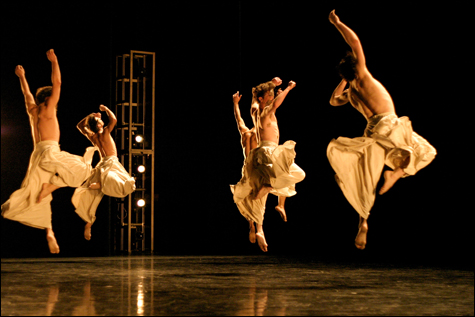
OPEN-ENDED POSTMODERNISM: The Minus series is personalized to the performing company. |
Ohad Naharin’s Minus One isn’t a single piece of choreography. It’s a floating collage he puts together from previous works and adapts for the company performing it. Boston saw a shorter version (Minus 16) four years ago when Hubbard Street Dance Chicago brought it to town. Last weekend, Les Grands Ballets Canadiens de Montréal presented a 90-minute jumbo edition at the Cutler Majestic, courtesy of the Celebrity Series.
Naharin gave up his post as artistic director of Israel’s Batsheva Dance Company in 2003, staying on there as resident choreographer and pursuing his freelance career. The Minus series is a great success with audiences (I’ve seen versions by four different companies, from California to Copenhagen), but it’s more than a passing crowd pleaser. For one thing, it constitutes a portable Naharin repertory, keeping his choreographic sensibility in the public eye. But the dances aren’t frozen in some prescriptive form; they get worked on by the companies that acquire them, so they change while remaining basically the same.
Take the 20-minute solo that begins the work as the audience is arriving. I don’t know how much of this is improvised, probably a lot. The dancer has to keep going through a marathon of tacky cha-cha recordings, and how he handles the challenge tells you a lot about his dancer persona. One man I remember danced very close in to the body, with an internal focus, assessing, enjoying his own slinkiness. Friday night’s performer, Anthony Bougiouris, was an exhibitionist, doing huge, hammy takes on Latin dances, ballet moves, and body contortions, and the audience paused in taking off its coats to applaud him.
One reason the Minus excerpts can be tweaked and personalized is that most of them are based on open-ended postmodern structures. The postmodernists meant to reform dance by scraping away its excesses to expose its rock-bottom working materials, but they didn’t intend to erase it entirely. I think of the Minus idea, especially the Grands Ballets’ spectacular rendition, as postmodernism’s chickens coming home to roost.
Minus One can be quite spare, almost as didactic as its precursors. Six women line up on the edge of the stage and do a continuous sequence of slow, carving moves, to the ticking of a metronome. As they step sideways, one woman goes off stage and another enters from the other side to replace her. With an unlimited supply of dancers, the sequence could go on forever.
Individual dancers get to contribute their own small solos, which are accompanied by recorded “confessions” — maybe their own — of how they feel about dancing, their bodies, their life. Postmodernism rejected the idea of the single authoritarian choreographer. In Minus One, this section is further democratized by a variation of what Yvonne Rainer called a People Wall. During each solo, the other 10 dancers stand in line and watch, then move across the stage to absorb the solo dancer, and another person steps out to begin.
Civilians in the audience can be stars too, if they’re drafted to go up on stage as company members’ partners. The rest of the audience adores this part the most.